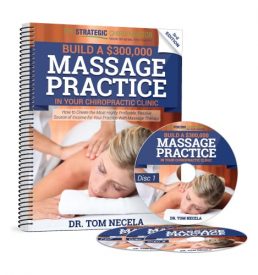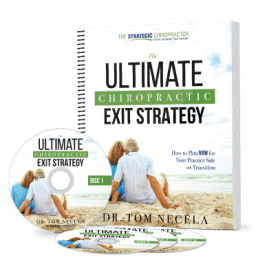Looking for a chiropractic associate job or looking to hire a chiropractic associate as a part of your practice’s transition strategy? Here are a few things you need to consider — regardless of which side of the fence you are on!
Young chiropractors are quickly becoming more risk-averse thanks, in part, to the $200,000 debt burden some of the new doctors are beginning their career in chiropractic with. In decades past, many (if not, most) chiropractors graduated and then moved towards starting up their own practices as quickly as they could get licensed. These days, chiropractic associates are moving a little more slowly into entrepreneurship because of a larger mountain of debt and perhaps, a bit more business cynicism (or savvy) on the topic of what it takes to succeed in chiropractic today.
While this trend may be a bit of a switch from chiropractic’s past, it can be seen as a sign of the maturity of our profession, as we now more closely resemble the mainstream of dentistry, medicine, law and other professions than the “fringe.” And true to form, it’s a rare occurrence for a solo dentist to start from scratch and even rarer to find a solo MD or attorney.
Similarly, while new chiropractors may be a bit hesitant about starting their own practice behind their burden of debt, with no business experience and little financial backing, many DC’s warmly welcome the opportunity to become an associate with an opportunity to own, a partner in a successful practice or to purchase an existing chiropractic business.
Interestingly enough, the first option (associate with an opportunity to own) is perhaps both the most offered and the most mangled of the three ways mentioned of transitioning into business. But it doesn’t have to be that way.
So that’s the topic of today’s post.
Dissecting the “Art” Of Associateships
Many who have attempted to navigate an associate buy-in or buy-out (from either side of the fence) would say that the associate to owner route is an art form. The rumors (or unfortunately real-life experiences) make young chiropractors reluctant to join forces with a chiropractor who is looking to transition out in time. On the surface, this should be a great opportunity for both DC’s. The older wants to step out; the younger wants to step-in.
But the horror stories heard get in the way of the success stories. So let’s examine the parts that typically go wrong to see how we can fix this potentially win-win situation.
Associate Buy-In and Buy-Out Mistakes
The Train That Never Arrives. Chief among the associate transition errors is the buy-in or buy-out that never happens. After a couple or more years of listening to the plans and promises of the senior doctor who threatens to retire, the associate suddenly realizes, “This doc is never going to slow down or step out.” The senior doctor, who hired the associate to have more time, to slow down and to eventually transition, never takes additional vacations, has no concrete transition plan for how or when a transition will happen and shows no signs of slowing down. The associate anticipates that they have no future or that the future is so far away, they simply cannot wait for that train to arrive. And so the buy-in or buy-out never materializes, the relationship fizzles and both parties part disappointed in the outcome.
The Lopsided Deal: On the opposite side of the fence is the owner who has an outlined plan for the buy-in or buy-out which looks good to them. But upon closer examination, the associate feels like they are paying to buy the practice they have helped build. Truth be told, the associate did contribute to the current collections, but he or she did not build the practice (which has probably been existence decades longer than the associate has been in practice). So the reality here is that the deal feels a bit lopsided to the associate and therefore, unattractive.
Paying for Potential. There is a third common type of associate buy-in or buy-out bomb that destroys a practice sale and it is the fact that the owner is attempting to sell the potential of the business. The owner hires an associate based on the hope that the associate will grow the practice (bad move) and, in time, attempts to transition the practice to the associate by selling the same potential (worse move). The owner is tired and feels that if the associate would just work more, market more or tap into all the unrealized glory of the business, they could have a goldmine on hand. The associate, of course, sees it a different way. They see the practice is not as busy as it could be and they see there is no current marketing or systems in place to boost the business. So, the associate feels that these all spell one thing for a practice purchase: bargain. They are not really willing to purchase potential, but they may be willing to purchase the practice at a heavily discounted price to reflect the amount of heavy lifting that will be required to get the practice going in a better direction.
Financial Hurdles. Perhaps the biggest challenge to associate buy-in or buy-outs are financial obstacles (on either side of the fence). It is possible that the owner needs to get a certain amount from the practice sale to fuel their retirement; and sometimes, that leads practices to become over-priced. More commonly, however, it is the associate that creates the financial challenges. They are deep in debt. Their credit scores are less than stellar. They have no money for a downpayment, no collateral or no relatives willing to help them with some money. The worse cases have all of these factors combined (or more). In short, the associates believe they cannot qualify for a loan and that the owner must finance the sale. This thought alone is enough to send many owners and associates running the other way.
Lack of Planning: The final mistake actually encompasses all of the above and the cold hard fact that most chiropractors have never orchestrated a successful buy-in or buy-out and therefore, don’t really know what they are doing. The owner doesn’t have much of a plan and the associate basically has none. Even if the owner has an idea, they don’t know how to implement their idea from start to finish and put it to the paper so that it can be clearly spelled out for everyone to see. So, when the idea lacks implementation steps and questions arise, the plan gets pushed to the right and to the left and eventually out of the bounds of possibility.
Solutions to Successful Chiropractic Associate Buy-In and Buy-Outs
With all of these landmines threatening to blow up your transition plans or practice opportunity, how does one create a successful associate buy-in or buy-out arrangement that actually works.
Start with simple. In our experience of helping hundreds of chiropractors create an effective transition plan, the best ones immediately avoid the mistakes that most of the worst deals make. In other words, start by reversing the above errors and you will be well on your way to making your associate buy-in or buy-out work. Here’s a few suggestions:
Definitions. First and foremost, define what things will look like. Will this be a purchase that happens in 2 years, 5 or 10? Will this be a buy-in (a timed sale where the associate puts down some money and pays off the remainder in installments) or a buy-out (where the associate puts down no money and works on a sweat-equity arrangement to earn their installment payments). Will their be owner financing, bank financing, both? Define what you are going for.
Establish Fairness on Both Sides of the Fence. To avoid the lopsided deal where one side is going to hit a home-run and the other side is not sure that this is a good thing, do a basic emotional check of the transition terms. A fair situation will usually have both sides excited with anticipation and having to make a few concessions to help sweeten the deal for the other side. In other words, if you feel like “I’ve got to hurry and get this signed before the other doctor looks into these details and runs away,” it is probably not a fair or equitable arrangement.
Solve the Big Picture Puzzle. Many doctors love to run to the end of the transition game and get the paperwork drafted immediately. They act as if there is some sort of magical contract that will automatically seal the deal and make the other party sign on the dotted line. In our experience, this is completely backwards. If the two parties can’t agree verbally on what is going to happen, no contract will save them. In fact, quite the opposite can occur. Introduce a contract too soon and you will have the doctors, their accountants, attorneys and every other advisor they know fixating on the fine print in the paperwork when the puzzle of the big picture remains unsolved. Negotiate the terms as chiropractors, then put it on paper.
Presentation Matters. Many time during an associate buy-in or buy-out, the owner doctor doesn’t understand why the associate would not want this opportunity being presented to them. The senior DC often feels that they would have been blessed to have such an opportunity to fall into their laps when they were younger docs. And this is probably true. The reality of the situation is that is it not a problem with the opportunity; it’s a problem with the presentation. Had the owner acknowledged the associate’s contributions and presented the purchase as an opportunity to own a practice with momentum built-in, the two doctors might have made some progress. In short, presentation matters, do it right.
Figure Out the Financing. While many DC’s attempt to bring out the contracts too early, an equal number (or greater) figure out the financing too late. In reality, financing is a huge obstacle and one that can change the entire shape of your deal. For example, if you are unwilling to finance anything towards the purchase of your practice and your buyer has no money and no bank to lend them any, you are effectively sunk. Why bother spending all the time on the paperwork if your transition can never set sail? This is why my first recommendation is to figure out the financing sooner. (The second is below).
Lead Your Buyer to the Lender. Because we know financing is a challenge for many associate chiropractors, the second thing we recommend is to “lead” your buyer to the lenders. Over the years, we have found out (sometimes the hard way) that most associate chiropractors will instinctively make either the wrong choice or no choice when it comes to finding financing. Either the doc will go to their local bank (who may have little to no experience with practice acquisition financing) and get rejected for their loan; or they will never get out of the starting gate because they don’t know where to obtain this specialized financing (because some banks won’t lend to chiropractors for practice sales and they’ve heard this). Either route inevitably leads to failure. So, to improve your buyer’s chances to succeed you have to help them through the process of finding the right banks that will lend, getting them the financial info they need and, in general, being as helpful as possible. This is so necessary that we teach our transition coaching the entire process of leading the buyers to the lenders (including giving them a list of recommended lenders based on the bank’s financial criteria) so that they don’t fail at this critical stage in their transition. Put simply, don’t leave all of this in your buyer’s hand – if you want to succeed. Because if the buyer fails, they will come back with one of two answers: your practice is not worth what you said it’s worth because the bank won’t lend (not necessarily a true statement) or YOU need to finance me because the bank won’t (maybe not something you want to do!).
Pursue the Plan: Associate Buy-In and Buy-Outs fail for many of the same reasons that marriages don’t all succeed: after the honeymoon, there’s plenty of work to do. But as any happily married person will attest to, the work is so worth it. While marriage may not have a step-by-step manual to get through, transitions are fortunately a bit less complicated. That said, if you don’t have a tangible idea of the steps required and the plan to get you there, you probably won’t arrive. (Which is one reason why many docs serious about making the associate buy-in or buy-out work choose to seek out chiropractic transition coaching help). In short, get a plan and pursue it. In the end, both parties are better for it.
The Good News
For those of you who may have lost hope (on either side of the equation – as the owner or as the associate), there is good news.
There is nothing inherently wrong with these transition options.
While our collective chiropractic experience may have seen many of these deals go sour, as mentioned above, Associate Buy-Ins and Buy-Outs are the norm in many other professions. Interestingly enough, they will also fail when the above conditions are ignored – in any profession.
So make sure that you pay close attention to the “art” of creating a successful associate buy-in or buy-out by implementing the strategies above (and avoiding the errors) and you too will be able to experience the success and benefits that many thousands of chiropractors, dentists, medical doctors, attorneys and other health professionals have in their transition as well!
And, if you need help along the way, consider these options:
For Associates — Or Those Seeking an Opportunity to Own a Practice (Sooner or Later)
There are docs who absolutely understand, agree to and are committed to making a win-win transition happen in their practice. And they are looking for like-minded chiropractors like you! Want to meet them? Here’s how: complete a simple one-minute form to register for our FREE Practice Matching Service where we hook you up with chiropractors looking for associates, offering opportunities for buy-ins and buy-outs and even practices for sale. All you need to do is register and tell us what you are looking for (and where) and we’ll be happy to match you up. Register today!
For Owners — Looking to Hire Associates, Offer Buy-In or Buy-Out Opportunities or Sell Your Practice
We’d be happy to help you reach your transition goals if you are the type of chiropractor who is also interested in a win-win transition that will be good for you, good for the other doc and good for our profession. If you are looking to transition sometime with the next five years, the best place to start is to view our NEWLY UPDATED Sell, Switch or Slow Down Webinar to discover strategies on how you can do just that successfully and avoid the mistakes many chiropractors make. The webinar is FREE so register and be on your path to transition success!









